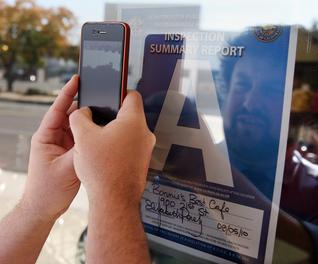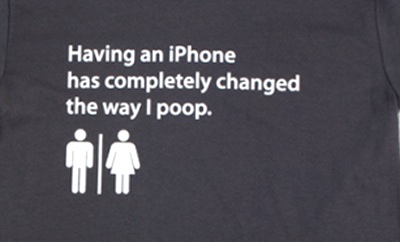Providing information about food – or anything else – needs to be layered to meet the needs of individual consumers.
Most people don’t care. But some want everything.
The mandatory posting of restaurant inspection grades is a way to provide a snapshot of information to diners as they enter an establishment. But with all those newfangled portable gadgets out there like iphones and ipads that baffle me but my 2-year-old can handle with ease, some are trying to provide additional information – for those who care.
Bakersfield.com reports that Kern County Environmental Health officials in California are backing up the letter grades they issue to restaurants with some technological muscle,  giving diners the power to access detailed inspection reports of food businesses through their mobile phones and other data devices.
giving diners the power to access detailed inspection reports of food businesses through their mobile phones and other data devices.
County regulators started printing a small, square "QR" code on all of the letter grade cards they post in the front windows of food establishments.
If your phone or data device can take a picture and surf the Internet, then downloading a QR code reader application will allow you to use your camera to scan that box of data (right, photo by Casey Christie, The Californian).
Public Health Department Director Matt Constantine said the code on the posted grade cards sends the person scanning the information to the county’s inspection report page, where they can input the name of the restaurant and pull up the establishment’s inspection history.
Restaurants are already required to keep a paper copy of their most recent inspection report on hand and give it to anyone who asks for it.
So far only a few restaurants — Tahoe Joe’s in the Marketplace, a Starbucks on Olive Drive, 24th Street Cafe, among others — have the codes on their grade cards.
Michelle Rowley, who stopped by Bonnie’s Best Cafe in downtown Bakersfield Thursday to pick up a phone order, uses the grade cards all the time and loves the idea of having more access to information.
 "I won’t eat at anything less than a ‘B.’ Sometimes I wonder how some places get an A," she said.
"I won’t eat at anything less than a ‘B.’ Sometimes I wonder how some places get an A," she said.
A quick cell phone search, triggered by the grade card in the window nearby, shows Bonnie’s Best has a stellar 99 point A grade with only a couple "non-critical" problems — a leaking faucet in the food prep area and an improper wastewater disposal practice.
Rowley said she was actually surprised that the county had come up with such a clever way to use technology to serve the public.
"It’s more technologically advanced than I would expect government in California to be.”





 while in the bathroom.
while in the bathroom. giving diners the power to access detailed inspection reports of food businesses through their mobile phones and other data devices.
giving diners the power to access detailed inspection reports of food businesses through their mobile phones and other data devices. The Brits have a problem with vomit: people do it too often and in public, often outside the pub.
The Brits have a problem with vomit: people do it too often and in public, often outside the pub.